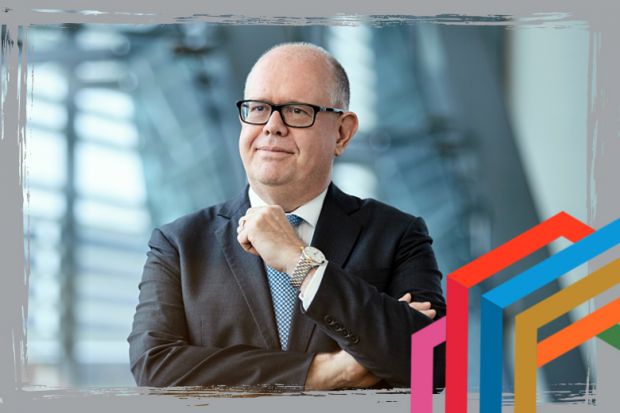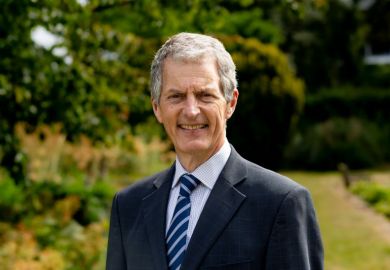People might imagine that consistently securing a high position in Times Higher Education’s Impact Rankings means an institution has deliberately focused its activities around the United Nations’ Sustainable Development Goals. That, however, is not the approach that has made the University of Technology Sydney a fixture in the tables. It may seem counter-intuitive, given that the rankings are based on the SDG framework, but as Andrew Parfitt, the UTS vice-chancellor and president, explains, starting with a broader outlook has allowed the institution to focus on areas where staff have expertise and passion.
Although UTS is a big institution, it is “not comprehensive”, says Parfitt, which is why its strategy has been led by the skills and interests of its people rather than the SDGs. “[We] build on areas of strength, harnessing big challenges that people are passionate about.”
A large part of the university’s work on climate change comes out of the Institute for Sustainable Futures, a transdisciplinary centre. As one of the earliest research institutes at UTS, it works closely with businesses and government to develop “deep research partnerships” and has “built up over time quite a reputation for real policy impact”, says Parfitt.
Those deep relationships that have influenced policy were enabled, in part, by what Parfitt describes as a “porous campus”. Some private companies are based at UTS, often attracted by the presence of the most up-to-date technology and equipment – such as a vault that enables secure analysis for sensitive data, biologics facilities and a “data arena”, which allows 3D visualisation of information.
“We have a really strong strategy of engaging through our campus facilities with industry partners across a whole range of different sectors,” Parfitt says. This, he believes, enables partnerships that are better able to tackle sustainability problems.
“When multiple partners come in to tackle bigger problems, we’re also able to effectively generate value and leverage the soft infrastructure that’s needed for those partnerships – because partnerships don’t happen by accident,” he says.
“I think at least a part of why some of our work is really having an impact or making a difference is that it gets out to the real world pretty quickly.”
Where universities put their money can be a fraught subject, with students and staff often putting pressure on administrators to invest institutional funds ethically. UTS went on a journey of divestment from fossil fuels. Initially, it tried to influence its fund managers to shift their investment priorities towards more ethical products, but it eventually switched funds. What can others learn from this?
Be really clear about your time frame, Parfitt says, and communicate well from the outset. His institution had to establish a deadline by which it would switch funds if its original one did not look set to divest from fossil fuels, to make sure that it did not lose the support of the university community.
Parfitt also advises watching for signs that the fund is listening – or not. “When you cease to see the steps along the way, then you’re getting a clear signal that things are probably not going to change, or they’re not changing in the time frame that you want.”
When it comes to equality – which is covered most comprehensively by SDGs 5 (gender equality) and 10 (reduced inequalities) – an important issue for Australian universities is equal opportunities for Indigenous peoples. Indigenous Australians make up 3.7 per cent of the country’s population but only 1.5 per cent of university completions, and there has been a push to ensure greater access.
Parfitt admits that “we underperform in terms of our Indigenous student numbers”, although he claims that UTS’ success rate is higher than the sector average. To tackle the issue, he has a bold plan. “We’re fundraising and also looking for a partner to help build a First Nations College – a residential college, so that we have a place that people can come to.” Situated adjacent to campus, the college will house 250 students, as well as services unique to Indigenous students.
“It will be the first time that we’ll have a college where First Nations students will welcome others on to the territory, basically, rather than us welcoming them on to our campus. So it’s kind of turning that paradigm around,” Parfitt says, explaining that the idea came from the First Nations community at UTS.
“It’s not cheap, as you can imagine,” he adds. “But nothing that really makes generational change is going to be cheap.”
rosa.ellis@timeshighereducation.com
This is part of our “Talking leadership” series with the people running the world’s top universities about how they solve common strategic issues and implement change. Follow the series here.
Browse the full results of the Impact Rankings 2024
Register to continue
Why register?
- Registration is free and only takes a moment
- Once registered, you can read 3 articles a month
- Sign up for our newsletter
Subscribe
Or subscribe for unlimited access to:
- Unlimited access to news, views, insights & reviews
- Digital editions
- Digital access to THE’s university and college rankings analysis
Already registered or a current subscriber? Login









